Doro Bundle
How Did Doro Company Become a Leader in Senior-Friendly Tech?
Ever wondered how a Swedish tech company became a global leader in accessible technology for seniors? Doro Company's story is a fascinating journey of strategic pivots and innovative solutions. From its origins in 1974, the company identified a crucial need in the telecommunications market. Their focus on Doro SWOT Analysis has shaped its trajectory.
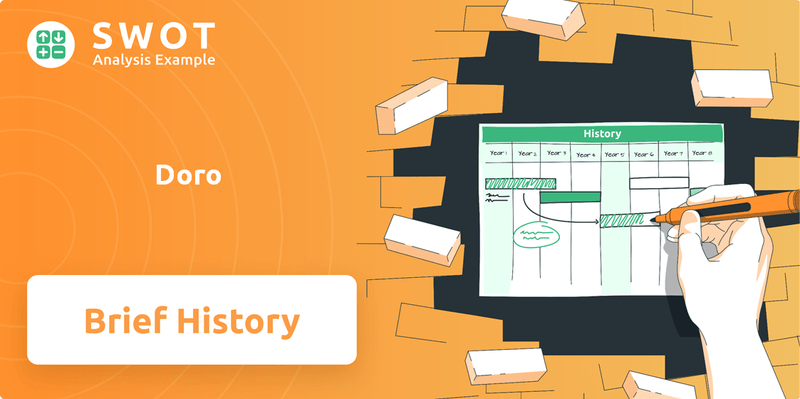
This article delves into the brief history of Doro mobile phones, exploring how a company initially involved in broader telecommunications evolved to specialize in senior-friendly devices. We'll uncover the key milestones, from early ventures to the release of Doro phones, and examine the strategic decisions that positioned Doro as a prominent player in the market. Discover the evolution of Doro phones, and how this Swedish tech company continues to address the needs of an aging population.
What is the Doro Founding Story?
The Doro Company, a Swedish tech company, has a story rooted in the telecommunications sector. The company's journey began in 1974 in Lund, Sweden. The initial focus was broader within the telecommunications field before a pivotal shift that defined its current identity.
The evolution of Doro phones is marked by its dedication to senior-friendly devices. This focus emerged from the recognition of a significant market gap: the lack of mobile phones and communication devices tailored to the specific needs of seniors. As mobile technology advanced, many older adults struggled with complex interfaces, leading Doro to redefine its mission.
The company's initial product after the pivot was simplified mobile phones. These were designed with larger buttons, clearer displays, and louder sound. The company's early years involved bootstrapping and potential early investments as it grew and identified its niche. The cultural and economic context of the 1970s, with a growing emphasis on technological accessibility and an aging population, likely influenced Doro's eventual specialization.
Founded in 1974, Doro initially operated within the broader telecommunications sector before identifying a niche market.
- The company's focus shifted to address the needs of seniors, a demographic often overlooked by mainstream mobile phone manufacturers.
- Early products included simplified mobile phones with features like larger buttons and louder sound.
- The company's evolution reflects a responsiveness to market needs and a commitment to accessibility.
- The company's name, 'Doro', is straightforward and memorable.
The company's strategic pivot towards senior-friendly devices was a key decision. This move allowed Doro to establish a strong presence in a niche market. According to a 2024 report, the global market for senior-friendly technology is experiencing steady growth, reflecting the increasing demand for accessible technology solutions. This growth underscores the foresight of Doro's early strategic decisions. For additional insights into the competitive landscape, consider exploring the Competitors Landscape of Doro.
The initial funding sources for Doro would have been typical for a company founded in the 1970s. This likely involved a combination of bootstrapping and early investments. The company's ability to secure funding and grow its operations was crucial. The 1970s saw an increased focus on technological accessibility and an aging population, which influenced Doro's specialization. In 2023, the global market for assistive technology was valued at approximately $20 billion, highlighting the continued relevance and growth potential of the senior-focused technology market.
Doro SWOT Analysis
- Complete SWOT Breakdown
- Fully Customizable
- Editable in Excel & Word
- Professional Formatting
- Investor-Ready Format
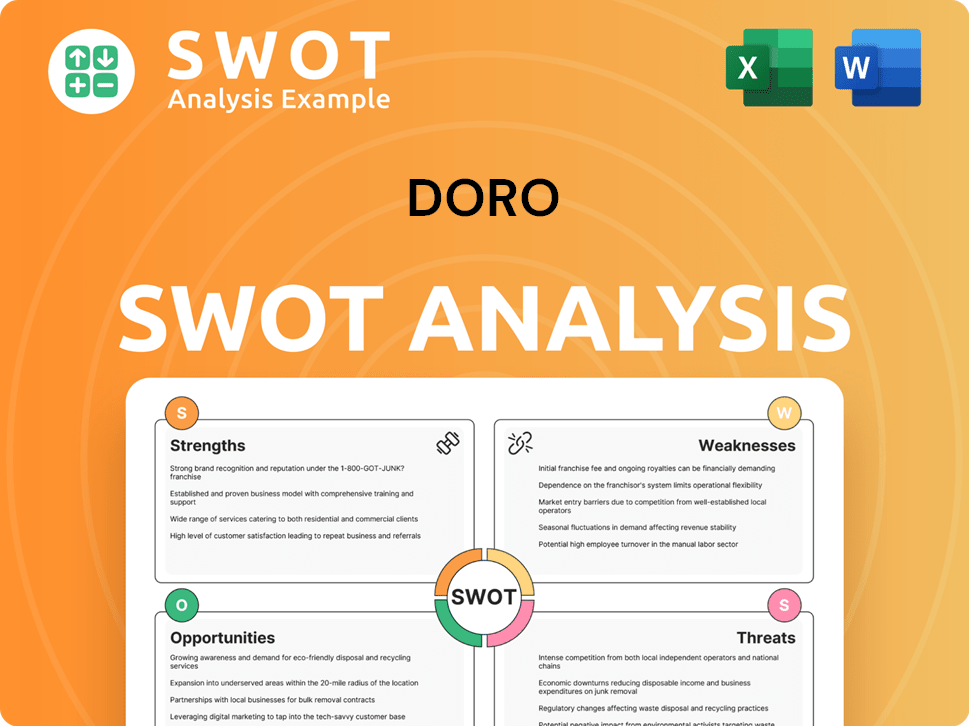
What Drove the Early Growth of Doro?
The early growth of the Doro Company, following its strategic shift towards senior-focused telecommunications, saw a steady expansion of its product range and market reach. Initial offerings of simplified mobile phones quickly evolved to include devices with enhanced safety features, such as emergency call buttons and hearing aid compatibility. This approach resonated with the market, establishing Doro as a key player in several European markets.
Doro's product portfolio expanded beyond basic mobile phones to include models with features specifically designed for seniors. These included large buttons, simplified interfaces, and compatibility with hearing aids. The company's focus on accessibility was a key differentiator, attracting a dedicated customer base.
Entry into new geographical markets was often facilitated through partnerships with local distributors and telecommunication providers. These collaborations were crucial for expanding the company's reach and adapting to regional market demands. This strategy allowed for efficient market penetration and brand building.
The company's operations grew, moving beyond initial small setups to larger offices and potentially dedicated research and development facilities, likely in Lund, Sweden. Leadership transitions occurred as the company scaled, bringing in expertise to manage international expansion and product development. This evolution was essential for sustaining growth.
As the market matured, Doro adapted its business model, expanding beyond hardware to include services that enhanced seniors' independence and safety, such as telecare solutions. This strategic shift was pivotal in maintaining its leadership. The company's ability to evolve its offerings is discussed in more detail in this article about Growth Strategy of Doro.
Doro PESTLE Analysis
- Covers All 6 PESTLE Categories
- No Research Needed – Save Hours of Work
- Built by Experts, Trusted by Consultants
- Instant Download, Ready to Use
- 100% Editable, Fully Customizable
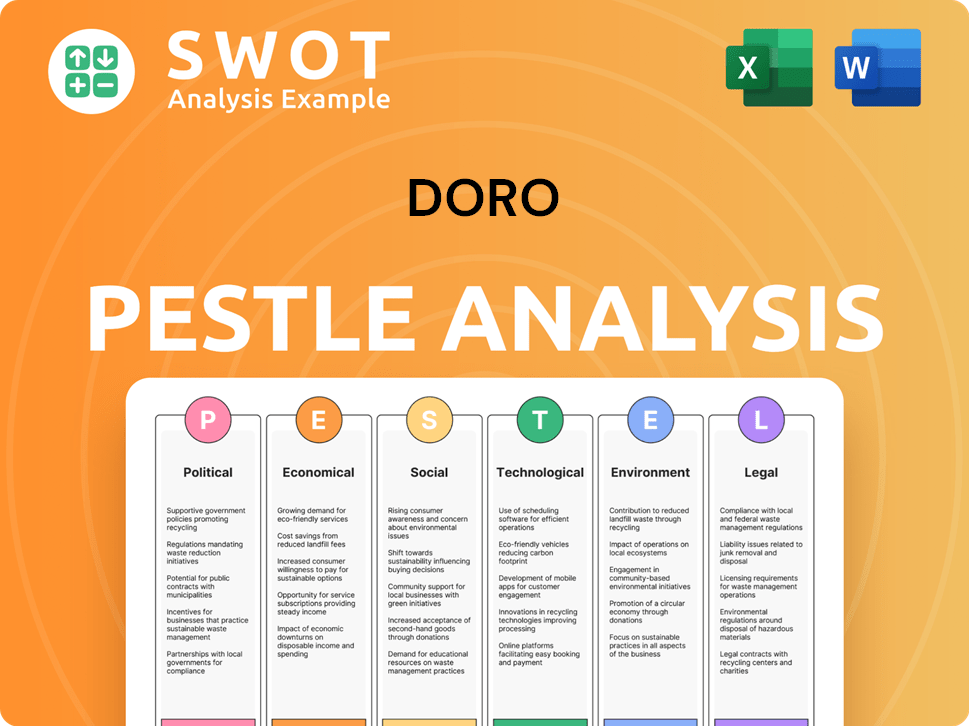
What are the key Milestones in Doro history?
The Doro Company's journey has been marked by significant milestones, reflecting its commitment to senior-friendly technology. The Doro history is a testament to its adaptability and focus on meeting the needs of an aging population. The company's evolution showcases its ability to innovate and respond to market dynamics, solidifying its position in the mobile phone industry.
| Year | Milestone |
|---|---|
| Early 2000s | The company was founded, focusing on mobile phones for seniors. |
| Mid-2000s | Introduced phones with simplified interfaces and large buttons, setting new standards for senior-friendly devices. |
| 2010s | Expanded product lines to include smartphones with customized Android interfaces and integrated assistance features. |
| Ongoing | Continued to develop and release new Doro phone models, incorporating the latest technology while maintaining ease of use. |
Doro phones have consistently introduced innovations tailored for older adults. These innovations include phones with integrated assistance buttons, GPS localization, and remote management capabilities, significantly improving safety and connectivity for older users. The company's focus on user-friendly design and accessibility has set it apart in the competitive mobile phone market.
Doro pioneered mobile phones with simplified interfaces, making them easier for seniors to use. This feature includes large, clear displays and intuitive navigation.
The inclusion of assistance buttons on Doro phones allows users to quickly contact emergency services or pre-selected contacts. This feature enhances safety and provides peace of mind.
Doro integrated GPS technology into its phones, enabling location tracking for added safety. This feature is particularly useful for users who may be prone to getting lost.
Doro developed remote management capabilities, allowing caregivers to assist users with their phones remotely. This feature simplifies technical support and troubleshooting.
Many Doro phones are hearing aid compatible (HAC), ensuring clear audio for users with hearing impairments. This feature enhances the usability of the phones for a wider audience.
Doro has adapted Android interfaces to be more senior-friendly, offering simplified menus and larger icons. This makes smartphones easier for older adults to navigate.
Doro has faced challenges, including market competition and the need to continually innovate. The company has responded to these challenges by evolving its product line and expanding its service offerings. Strategic pivots and restructuring efforts have been essential to adapt to market dynamics.
The mobile phone market is highly competitive, with mainstream manufacturers offering senior-friendly features. Doro has had to differentiate itself through specialized design and services.
Rapid technological advancements require Doro to continually update its products to remain relevant. This includes incorporating new features and improving existing ones.
Consumer preferences evolve, and Doro must adapt to meet new demands. This involves understanding the needs of an aging population and offering products that meet those needs.
Economic downturns can impact consumer spending, affecting sales of Doro phones. The company must manage its costs and adjust its strategies to maintain profitability during challenging times.
Disruptions in the supply chain can affect the availability of components and the production of Doro phones. The company needs to have robust supply chain management to mitigate these risks.
Reaching the target market effectively requires a well-developed distribution network. Doro must ensure its products are accessible through various channels, including retail and online platforms.
To gain further insights into the business model and revenue streams, consider reading Revenue Streams & Business Model of Doro.
Doro Business Model Canvas
- Complete 9-Block Business Model Canvas
- Effortlessly Communicate Your Business Strategy
- Investor-Ready BMC Format
- 100% Editable and Customizable
- Clear and Structured Layout
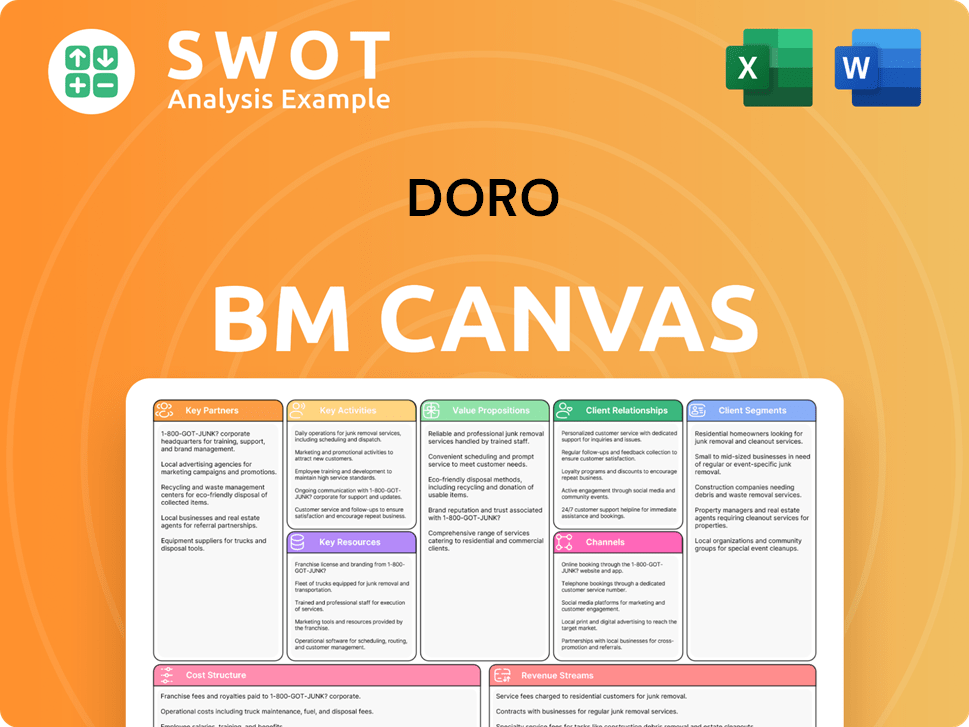
What is the Timeline of Key Events for Doro?
The Doro Company, a Swedish tech company, has a rich history. It is marked by strategic shifts and a consistent focus on serving the needs of its core demographic. The company's journey includes significant milestones, from its founding to its expansion into telecare solutions and the launch of senior-friendly devices.
| Year | Key Event |
|---|---|
| 1974 | Doro is founded in Lund, Sweden. |
| Early 2000s | Doro shifts its focus to developing easy-to-use mobile phones for seniors. |
| 2007 | Launch of the first Doro PhoneEasy, a significant step in establishing its senior-focused product line. |
| 2011 | Doro acquires CareTech, expanding into telecare and alarm solutions. |
| 2013 | Introduction of the first Doro Liberto smartphone, combining smartphone functionality with ease of use for seniors. |
| 2015 | Doro secures a significant share in the European senior mobile phone market. |
| 2018 | Doro acquires cut-e, a leader in online assessment, to further strengthen its digital offerings, though this acquisition was later divested. |
| 2019 | Launch of the Doro 8080, a smartphone with a simplified user interface and advanced safety features. |
| 22 March 2024 | Doro announces its full-year report for 2023, showing continued focus on its senior market. |
| 2024 | Doro continues to release new smartphone models, such as the Doro 8110, emphasizing accessibility and emergency features. |
The global senior population is steadily increasing, creating a growing market for senior-friendly devices. This demographic shift presents a significant opportunity for companies like Doro. The demand for accessible technology is expected to rise as the senior population grows.
Doro plans to integrate hardware with software and services to enhance its offerings. The company is developing more sophisticated telecare solutions. Exploring new markets, particularly in regions with rapidly aging demographics, is also a key focus.
Doro is leveraging AI and IoT to improve the safety and independence of seniors. This includes predictive analytics for health monitoring and smart home integration. The company's innovation roadmap emphasizes creating a broader ecosystem of connected care.
Analysts predict a continued strong market for Doro due to its specialized expertise and brand reputation. Leadership is committed to innovation and expanding service offerings. This approach aligns with the founding vision of empowering seniors through accessible communication.
Doro Porter's Five Forces Analysis
- Covers All 5 Competitive Forces in Detail
- Structured for Consultants, Students, and Founders
- 100% Editable in Microsoft Word & Excel
- Instant Digital Download – Use Immediately
- Compatible with Mac & PC – Fully Unlocked
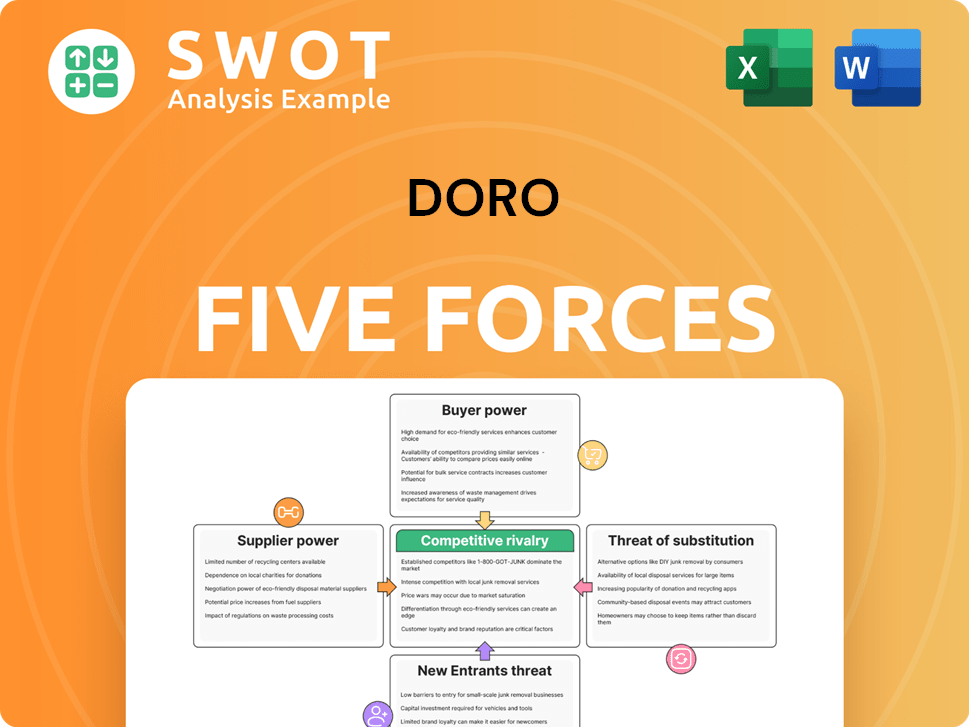
Related Blogs
- What is Competitive Landscape of Doro Company?
- What is Growth Strategy and Future Prospects of Doro Company?
- How Does Doro Company Work?
- What is Sales and Marketing Strategy of Doro Company?
- What is Brief History of Doro Company?
- Who Owns Doro Company?
- What is Customer Demographics and Target Market of Doro Company?
Disclaimer
All information, articles, and product details provided on this website are for general informational and educational purposes only. We do not claim any ownership over, nor do we intend to infringe upon, any trademarks, copyrights, logos, brand names, or other intellectual property mentioned or depicted on this site. Such intellectual property remains the property of its respective owners, and any references here are made solely for identification or informational purposes, without implying any affiliation, endorsement, or partnership.
We make no representations or warranties, express or implied, regarding the accuracy, completeness, or suitability of any content or products presented. Nothing on this website should be construed as legal, tax, investment, financial, medical, or other professional advice. In addition, no part of this site—including articles or product references—constitutes a solicitation, recommendation, endorsement, advertisement, or offer to buy or sell any securities, franchises, or other financial instruments, particularly in jurisdictions where such activity would be unlawful.
All content is of a general nature and may not address the specific circumstances of any individual or entity. It is not a substitute for professional advice or services. Any actions you take based on the information provided here are strictly at your own risk. You accept full responsibility for any decisions or outcomes arising from your use of this website and agree to release us from any liability in connection with your use of, or reliance upon, the content or products found herein.